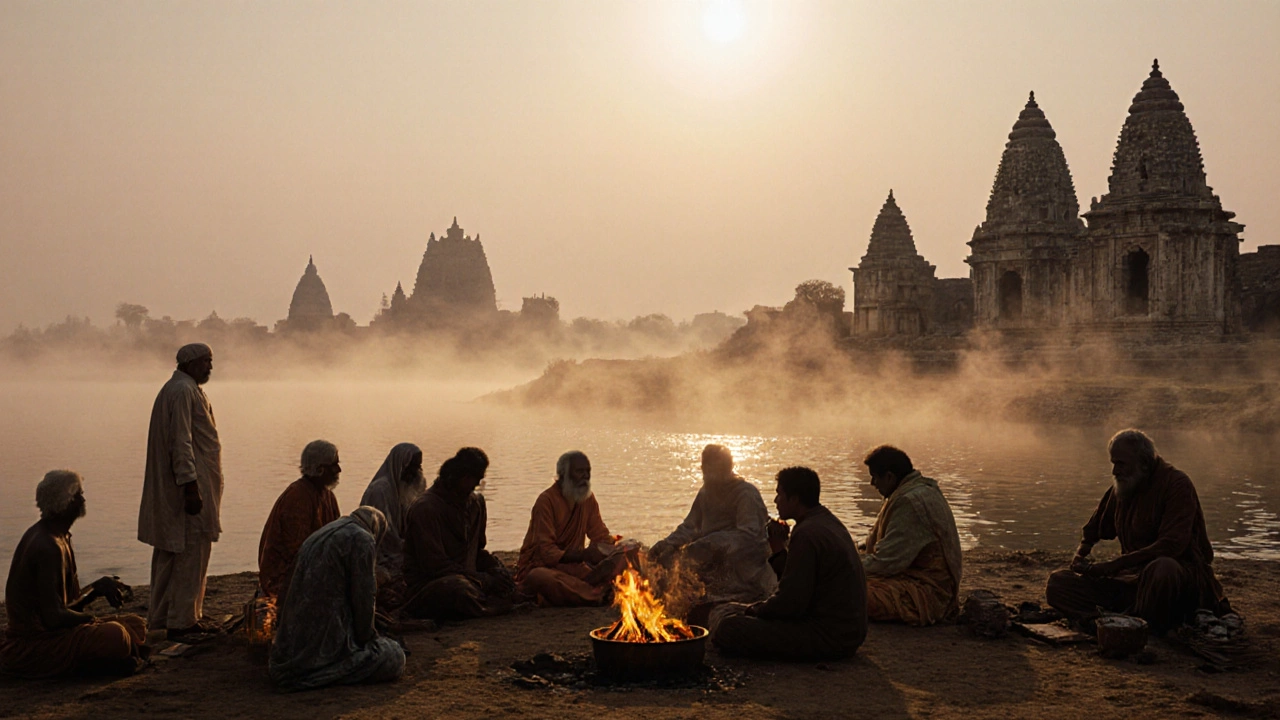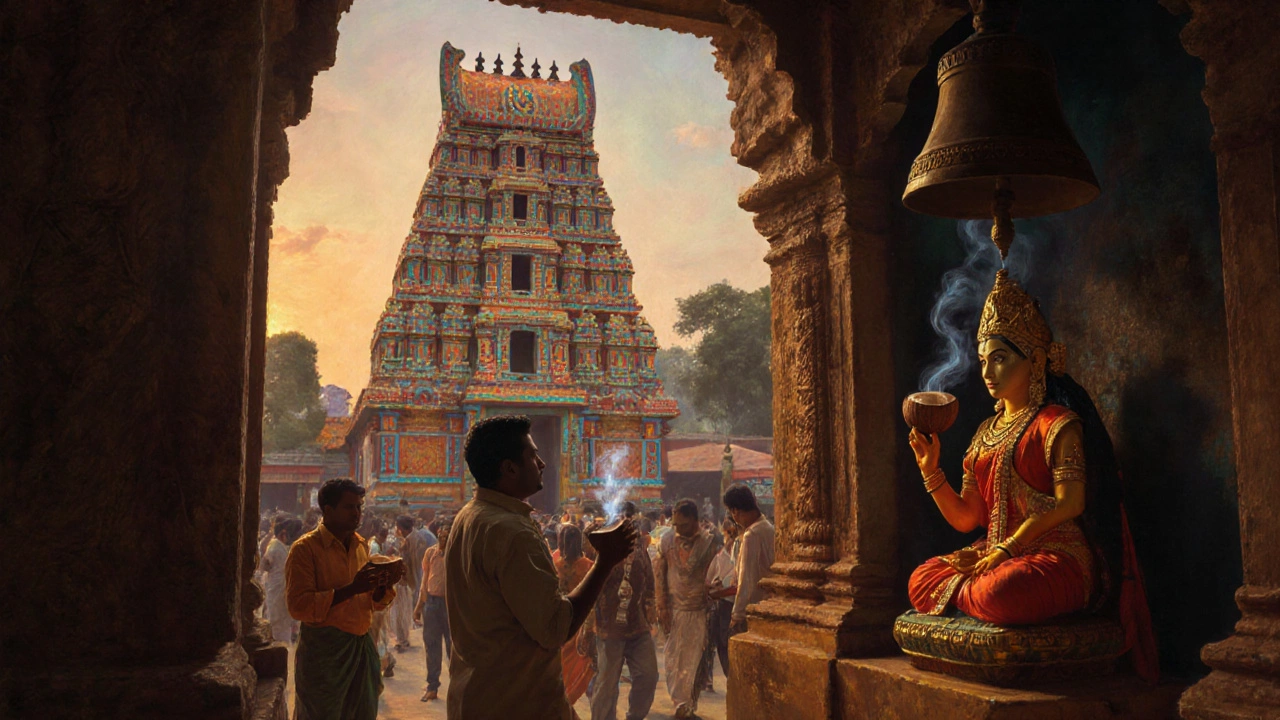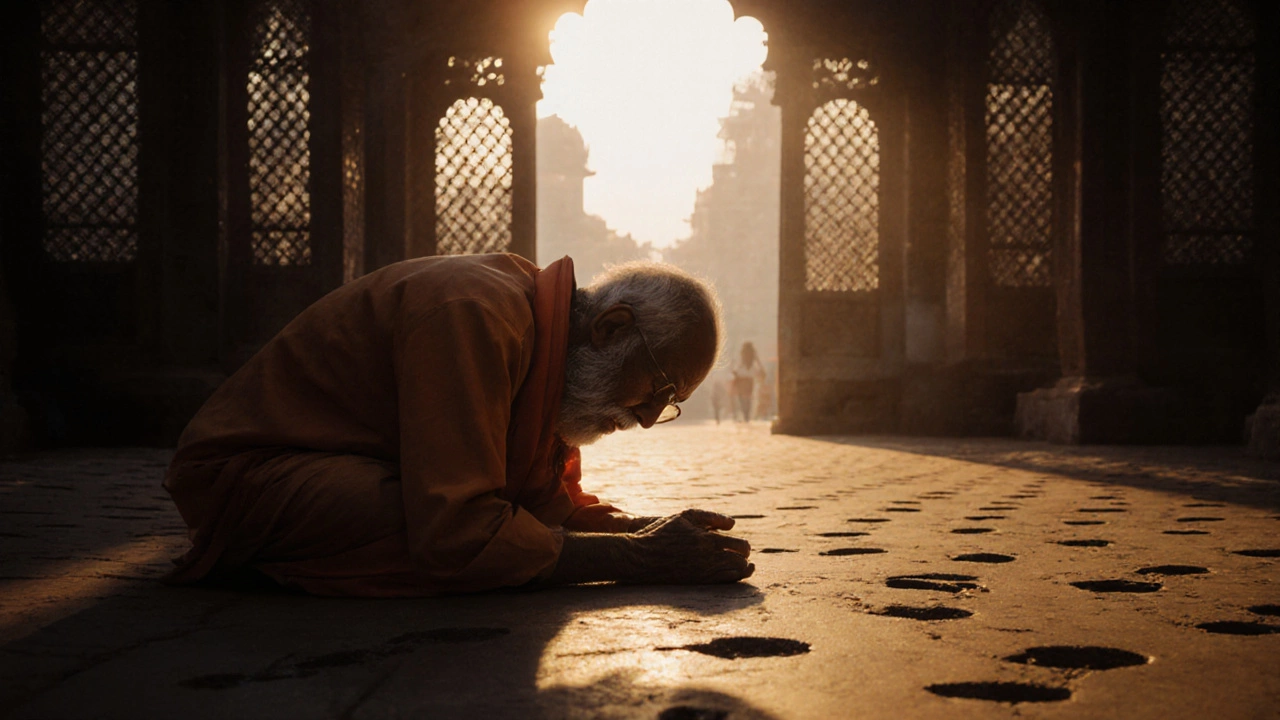Who Founded Hinduism? The Truth Behind Its Origins and How It Shapes Temple Tours in India
 Oct, 27 2025
Oct, 27 2025
Hindu Temple Tour Guide
Select Your Temple Region
Key Features
- Tall, curved shikharas (spires)
- Raised platforms
- Main deities: Vishnu, Shiva
Key Features
- Massive, colorful gopurams (gateways)
- Large courtyards
- Main deities: Shiva, Devi
Key Features
- Unique blend of styles
- Stone carvings of deities
- Main deities: Devi, Vishnu
What to Expect
When visiting Hindu temples, remember:
Dress modestly, remove shoes, and avoid pointing feet at deities. Most temples welcome visitors of all faiths, but some inner sanctums may be restricted. Accept prasad (sacred food) as a sign of respect.
There’s no single founder of Hinduism. That’s not a loophole in the story-it’s the whole point. Unlike religions that trace back to one prophet, teacher, or revelation, Hinduism grew over thousands of years like a vast forest, with roots spreading deep into the soil of ancient India. It didn’t start with a sermon. It started with people-farmers, poets, sages, and kings-asking questions about life, death, and the stars, and slowly building a way of understanding the world around them.
Why No Single Founder?
Think of Hinduism like a river. It doesn’t have one source. It gathers water from countless streams, tributaries, and springs across the Indian subcontinent. Some of those streams came from the Indus Valley Civilization over 5,000 years ago. Others came from the Vedic people who moved into the region around 1500 BCE, bringing hymns, rituals, and gods like Indra and Agni. Over time, these traditions merged with local beliefs, philosophies from the Upanishads, and the teachings of figures like the Buddha and Mahavira-some of whom were reacting against certain Hindu practices.
There’s no book that says, “This is Hinduism, written by Rishi X.” Instead, you have the Vedas-four collections of hymns and rituals-passed down orally for centuries before being written down. The oldest, the Rigveda, doesn’t name a founder. It names hymns, sages who heard them, and gods they praised. That’s the pattern: revelation, not revelation from one person.
Who Are the Key Figures in Hinduism’s Development?
While no one founded it, some people shaped it deeply. The sages of the Upanishads-like Yajnavalkya and Uddalaka Aruni-were among the first to ask: What is the self? What is the universe made of? Their answers laid the foundation for concepts like Brahman (the ultimate reality) and Atman (the inner soul), which still guide Hindu thought today.
Then there’s Vyasa, traditionally credited with compiling the Mahabharata and the Puranas. These texts didn’t create Hinduism, but they made it accessible. The Bhagavad Gita, part of the Mahabharata, turned philosophy into a conversation between a warrior and his charioteer-Krishna, who is also seen as an incarnation of Vishnu. For millions, Krishna isn’t just a character. He’s a living presence in temples across India.
Adi Shankaracharya, who lived around the 8th century CE, didn’t start Hinduism either. But he reorganized its scattered traditions into a coherent system. He traveled across India, debated scholars, and revived temple worship. He established four major monastic centers (mathas) that still exist today-in Sringeri, Dwarka, Puri, and Joshimath. These places became anchors for Hindu learning and practice.
How This Affects Temple Tours in India
When you walk into a Hindu temple-whether it’s the towering gopurams of Tamil Nadu or the quiet stone shrines of Khajuraho-you’re not just seeing architecture. You’re stepping into layers of history.
In South India, temples like Meenakshi Amman in Madurai are dedicated to goddesses who’ve been worshipped for over a thousand years. The rituals, the music, the offerings-all of it evolved from ancient Vedic rites mixed with local folk traditions. No single person designed this. It grew because people kept returning, kept singing, kept leaving flowers.
In North India, temples like Kashi Vishwanath in Varanasi are tied to the idea of moksha-liberation from the cycle of rebirth. Pilgrims come here not because a founder told them to, but because generations of their ancestors did. The belief isn’t imposed. It’s inherited.
That’s why temple tours in India feel so different from visiting cathedrals or mosques. There’s no single authority telling you how to pray. You might see someone chanting Sanskrit mantras, another offering coconuts to a statue of Ganesha, and a third just sitting quietly, eyes closed. All are valid. All are part of the same living tradition.

What Do Hindus Actually Believe?
There’s no official creed. You won’t find a list of ten commandments in Hinduism. Instead, there are guiding ideas:
- Dharma-doing your duty, living ethically based on your role in life
- Karma-your actions shape your future, in this life or the next
- Samsara-the cycle of birth, death, and rebirth
- Moksha-freedom from that cycle, the ultimate goal
And then there are the gods. Millions of them, in a way. But most Hindus focus on a few main deities: Vishnu (the preserver), Shiva (the transformer), and Devi (the divine mother, in forms like Durga or Lakshmi). These aren’t separate gods in a hierarchy. They’re different faces of the same underlying reality.
That’s why you’ll see a temple with a statue of Shiva one day, and the next day, the same space is decorated for Durga Puja. The space doesn’t change. The devotion does.
Modern Misconceptions
Many people think Hinduism is just “idol worship.” That’s a misunderstanding. The statues aren’t gods themselves-they’re reminders. Like a photo of your mother isn’t your mother, but it helps you remember her. The statue helps the devotee focus their thoughts, their love, their questions.
Others think Hinduism is outdated. But look at the numbers: over 1.2 billion people practice it today. It’s the third-largest religion in the world. It’s alive in cities like Mumbai and Delhi, in villages in Odisha and Kerala, and in homes across the globe-from Fiji to Florida.
Even in modern yoga studios in Vancouver or Berlin, people are practicing something that began in the forests of ancient India. Yoga, meditation, ayurveda-these aren’t trends. They’re ancient tools for balance, passed down through generations.

What Should You See on a Temple Tour?
If you’re planning a temple tour in India, here’s what to look for:
- Architectural style-North Indian temples have tall shikharas (spires), while South Indian ones have massive gateways called gopurams.
- Deity focus-Is it a Shiva temple? A Vishnu temple? A goddess shrine? Each has different rituals, music, and offerings.
- Timing-Many temples have daily rituals (pujas) at dawn and dusk. Watch one if you can.
- Community-Notice how people interact. Is it quiet? Joyful? Busy? It’s not a museum. It’s a living space.
- Language-You’ll hear Sanskrit chants, Tamil hymns, or Hindi prayers. Even if you don’t understand, feel the rhythm.
Don’t expect a single answer. Don’t look for a founder. Look for patterns. Look for continuity. Look for the quiet moments when someone touches their forehead to the temple floor and whispers a prayer that’s been whispered for centuries.
Why This Matters for Travelers
Temple tours aren’t just about sightseeing. They’re about understanding how belief lives in everyday life. You won’t find a founder’s name on a plaque. But you’ll find his voice-in the ringing of a bell, in the scent of incense, in the silence between chants.
When you visit a temple in India, you’re not just seeing history. You’re walking through a tradition that never stopped. It didn’t need a founder because it was never meant to be owned. It was meant to be lived.
Is Hinduism the oldest religion in the world?
Yes, Hinduism is widely considered the oldest living religion. Its roots stretch back to the Indus Valley Civilization (around 3300-1300 BCE) and the Vedic period (1500-500 BCE). Unlike religions that began with a single prophet or event, Hinduism evolved over millennia through texts, rituals, and regional practices. It’s still practiced today by over a billion people, making it both ancient and alive.
Do Hindus worship idols?
Hindus don’t worship statues as gods themselves. The statues, called murtis, are physical representations used to focus devotion. Think of them like a photograph of a loved one-it’s not the person, but it helps you feel connected. The belief is that the divine can be present in the image during worship. This practice is called darshan-seeing and being seen by the divine.
Are all Hindu temples the same?
No. Hindu temples vary widely by region, deity, and tradition. North Indian temples often have tall, curved spires (shikharas) and are built on raised platforms. South Indian temples feature massive, colorful gateways (gopurams) and large courtyards. Temples dedicated to Shiva have a lingam as the main symbol, while Vishnu temples often have statues of him with his four arms holding a conch, discus, lotus, and mace. Each temple reflects local culture, history, and devotion.
Can non-Hindus visit Hindu temples?
Yes, most Hindu temples welcome visitors of all faiths. However, some inner sanctums (garbhagriha) may be restricted to Hindus. Visitors should dress modestly, remove shoes before entering, and avoid pointing feet at deities. It’s polite to ask before taking photos, especially during rituals. Many temples offer free meals (prasad) to all guests-accepting them is seen as a sign of respect.
Why are there so many gods in Hinduism?
Hinduism sees the divine as one ultimate reality-Brahman-but expresses it in many forms to suit different needs and personalities. These forms are called deities: Vishnu for preservation, Shiva for transformation, Devi for power and motherhood. Most Hindus choose one primary deity (ishta devata) to focus their devotion on, while still respecting others. It’s not polytheism in the Western sense-it’s a way of approaching the infinite through the familiar.
Next time you’re on a temple tour in India, don’t look for a name carved on a stone. Look for the hands that lit the lamps, the voices that sang the hymns, the feet that walked these paths for generations. That’s where Hinduism lives-not in a founder’s story, but in the quiet, enduring rhythm of belief.